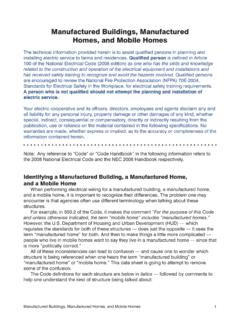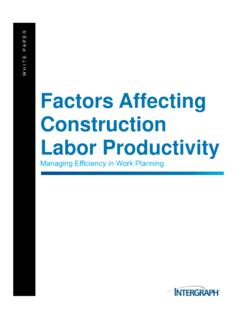Transcription of Grounding & Bonding — Why it is done And How to Install ...
1 Grounding & Bonding 1 Grounding & Bonding Why it is doneAnd How to Install ProperlyThe technical information provided herein is to assist qualifi ed persons in planning and installing electric service to farms and residences. Qualifi ed person is defi ned in Article 100 of the National Electrical Code (2008 edition) as one who has the skills and knowledge related to the construction and operation of the electrical equipment and installations and has received safety training to recognize and avoid the hazards involved. Qualifi ed persons are encouraged to review the National Fire Protection Association (NFPA) 70E-2004, Standards for Electrical Safety in the Workplace, for electrical safety training requirements.
2 A person who is not qualifi ed should not attempt the planning and installation of electric electric cooperative and its offi cers, directors, employees and agents disclaim any and all liability for any personal injury, property damage or other damages of any kind, whether special, indirect, consequential or compensatory, directly or indirectly resulting from the publication, use or reliance on the material contained in the following specifi cations. No warranties are made, whether express or implied, as to the accuracy or completeness of the information contained : Any reference to Code or Code Handbook in the following information refers to the 2008 National Electrical Code and the NEC 2008 Handbook respectively.
3 A home s electrical Service Equipment is a critical component of the home s electrical wiring system. Not only does it have to be sized properly to carry the electrical load, but it has to be installed properly. In addition, all of the home s branch circuits and feeders along with various metallic systems found within the home have to be connected properly back to the Service Equipment in order to safeguard the occupants of the home. This discussion identifi es what constitutes the Service Equipment; what Grounding is; the various types of Grounding electrodes, the systems that have to be bonded, and a thorough discussion on why Bonding is performed.
4 For this discussion, we will be referring to a residential home, where a 120/240-volt single phase 200 amp electrical supply from a cooperative transformer is delivered to the home via either overhead or underground conductors. At the home, a meter base is mounted outside and a 200 Amp Main Breaker Panel is located immediately adjacent inside the EQUIPMENT The Code defi nes Service Equipment as the necessary equipment, usually consisting of a circuit breaker(s) or switch(es) and fuse(s) and their accessories, connected to the load end of service conductors to a building or other structure or an otherwise designated area, and intended to constitute the main control and cutoff of the & Bonding 2 In our example, the Service Equipment for the home is the 200 Amp Main Breaker Panel.
5 However, if this 200 Amp Main Breaker Panel can t be immediately installed on the other side of the wall from the meter base, the electric cooperative may require a 200 Amp Main Disconnect be installed immediately after the meter base. (Note: The authority having jurisdiction in many cases that is the electric cooperative will determine what the length of run can be between meter base and the Main Breaker Panel before a Main Disconnect is needed. The Code does not specify this length.) See exhibits 1 & 2. If a Main Disconnect is installed, the electrician would also need to Install inside the home a 200 Amp Lug Main Panel ( Lug Main means without a Main Breaker).
6 In this type of arrangement the Service Equipment would consist of just the Main Disconnect and not include the lug main breaker panel inside the home. It is interesting to note that even though the meter base is usually installed when the Service Equipment is installed the Code does not recognize it as part of the Service Equipment according to Also, when installing conduit between the meter base and the Service Equipment, non-metallic conduit is preferred over metal. The reason is simple. The neutral terminal in the meter base is by design connected to the metal enclosure of the meter base and the neutral conductor is bonded to the metal enclosure of the Service Equipment.
7 So, when one use metallic conduit between the meter base and the Service Equipment, any neutral current between the meter base and the Service Equipment is being shared by both the neutral conductor and the metallic conduit because in essence they are in & Bonding 3 Meter BaseService EquipmentExhibit 1 Mounted Immediately after meter base on interior JumperNon-metallic ConduitGrounding & Bonding 4 Meter BaseService EquipmentMain DisconnectLug Main Breaker PanelExhibit 2 Mounted Immediately after meter base on interior ConduitNon-metallic ConduitMainBondingJumperGrounding & Bonding 5 Grounding AND Bonding Grounding and
8 Bonding are important elements of a building s electrical wiring system. They each have different functions, but they work together to make the building s electrical wiring safe. The Code defi nes Grounding as the connecting to ground or to a conductive body that extends the ground connection and the Code defi nes ground as the earth. Basically, Grounding is connecting to the earth. The Code defi nes bonded or Bonding as connected (connecting) to establish electrical continuity and conductivity. Let s examine these two important integral parts of electric wiring closer in In our home example, a typical electrical installation will require the electrician to connect the house s wiring to the earth.
9 This practice is called Grounding and it is done to limit the voltage imposed by lightning, line surges, or unintentional contact with higher-voltage lines and to stabilize the voltage to earth during normal operation as documented by (A)(1) of the Code. Grounding is necessary to prevent fi res starting from a surface arc within the home. If the outdoor wiring supplying the home should be struck by lightning, proper Grounding by the electrician directs that voltage into the earth where it dissipates. Because of the Code requires the neutral conductor of a single-phase, 3-wire system to be grounded, in our example, the electrician will normally use a bare copper wire to connect the neutral conductor (often called the grounded conductor) to a Grounding electrode that has direct contact with the earth.
10 Location of the Grounding Connection Each premises wiring system supplied by a grounded ac service shall have a Grounding electrode conductor connected to the grounded service conductor at each service according to (A) of the Code. Basically, this is saying each building that is served electricity shall have its service connected to the earth. (A)(1) of the Code allows this Grounding connection (earth connection) to be at various locations. It says the Grounding electrode conductor connection shall be made at any accessible point from the load end of the service drop or service lateral to and including the terminal or bus to which the grounded service conductor is connected at the service disconnecting means.









